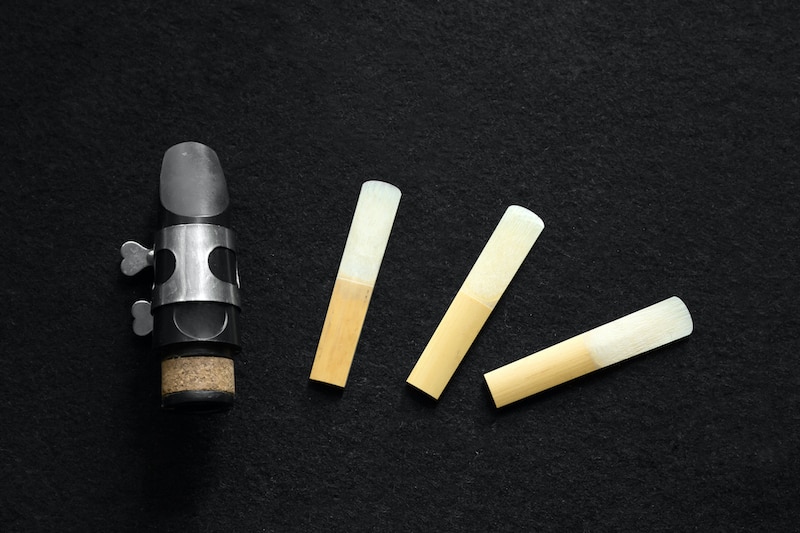Tuning a clarinet can be an intricate process that requires some patience and practice to get right. Knowing whether it’s even in tune is a skill that takes years to develop. There are a number of different conditions that may affect the tuning of the instrument and minor adjustments may be needed throughout the time that it’s being played.
In this post, we’ll give you a step by step walkthrough of how to tune a clarinet to play in tune every time.
Step By Step Clarinet Tuning Process

There are a few steps to follow and a few intricacies to keep in mind when tuning a clarinet.
This step by step guide will ensure that your intonation is just right every time.
It’s also worth noting that these steps will work on every type of clarinet.
Step 1: Warm Up
Temperature has a big affect on all instruments causing them to shrink and expand.
It’s most likely that the clarinet will cool down in the case and warm up when being played, which will undoubtably change the intonation.
That’s why warming up is crucial to ensuring that your clarinet will play in tune as if you try to tune it before warming up, you’ll have to go back and tune again anyway.
To warm up your clarinet, play through your regular warm-up exercises like a few scales and long tones to get the instrument ready.
Step 2: Pull Out Your Tuner
Step 2 is when it’s time to get out the tuner and see where you stand.
Play through a few notes to see if you’re generally playing flat, sharp, or if you’re playing pretty much in tune.
Adjust your embouchure as needed to try to bring the notes closer to the proper tuning.
It’s also important to check multiple notes to know whether it’s just one or two notes, or the whole instrument that’s out of tune.
Open G through Bb notes are typically always sharper than the rest of the notes on clarinet so don’t rely solely on them when checking your tuning.
You also can’t skip over them or those won’t be in tune.
It’s typically recommended to tune on middle C, open G, Bb, and high G.
This will give you a good overall idea of the tuning on your clarinet.
(If you don’t have a tuner I use this one which works well for the clarinet.)
- An even more readable display, with a larger note name indication
- A wide detection range supports tuning for any instrument
- Calibration function is provided
Step 3: Tune Throat Tones Again
Due to their tendency to be sharp, it’s a good idea to check all of the throat tones before deciding that the clarinet is in tune.
The throat tones are the chromatic range from open G through Bb.
If the open G remains sharper than the rest of the notes, you can place your right hand fingers down to lower the pitch a little bit.
You may have to do a bit of trial and error to figure out the proper combination for optimal tuning.
Step 4: Adjust The Barrel
If your clarinet is playing consistently sharp, you’ll need to pull the barrel out.
If it’s consistently playing flat, push the barrel in.
All barrel adjustments should be minor as it shouldn’t take much to reach the proper tuning.
Move it slowly as you try to get the instrument in tune and experiment with the tuner to find the optimal position.
Step 5: Play Some Scales
Once you feel the clarinet is more in tune, play through a couple of scales to ensure that the clarinet is fully warmed up.
The chromatic scale is also a good choice because it’ll check your full range on the clarinet and all of the problem notes will get double-checked.
Make sure to listen closely to each note of the scales and check them against the chromatic tuner.
You may eventually learn to tune by ear but it’s still always a good idea to double-check against the chromatic tuner.
Step 6: Make Final Adjustments
At this point, the clarinet should be fully warmed up and you should have a good idea as to what the current tuning sounds like.
It should be pretty close but there may be a few more minor changes that will perfect your tuning.
Make the minor adjustments to your embouchure and/or your barrel position and you’ll be ready to play.
How Mouthpieces Can Affect Tuning

The mouthpiece that comes with a clarinet, commonly known as a stock mouthpiece, is almost always of subpar quality.
You also can’t just buy any mouthpiece to improve the tuning and sound quality of your clarinet.
You want to ensure that the mouthpiece says A440 for it to be of the proper tuning, this is referring to the pitch of the note A is 440 Hz.
As well that, you’ll want to look for a mouth piece that is easy to play as if you struggle with one type of mouthpiece, it’ll be harder to ensure good intonation.
Barrel Length and Tuning

Most clarinets come with a 66mm barrel as that’s the most commonly used to obtain optimal intonation.
However, some clarinetists will opt for a slightly different barrel length to play in tune with ease.
If you find that you consistently play flat, a 65mm barrel will raise the pitch slightly and vice versa, if you’re playing consistently sharp, a 67mm barrel may be helpful to lower the pitch slightly.
Having a barrel of the proper length for you can make a world of difference if the one included with your clarinet doesn’t seem to be fitting your needs.
Reed Strength
As you advance, you may need to adjust to different reed strengths.
Thicker, stronger reeds can produce a richer sound but also require better embouchure.
If the reed is too soft, you may find your intonation to be flat and if you choose a reed that is too hard, intonation tends to be sharp.
I recommend to my beginner students for them to start on size 1.5-2 like the ones below.
- Box of 10 clarinet reeds.
- Each reed has its own plastic case
From there, you can then make adjustments if it doesn’t seem to be the proper reed strength for you.
Embouchure
Embouchure is one of those words that you may quickly grow sick of hearing as a clarinetist.
However, having the proper embouchure is imperative for intonation and sound quality when playing the clarinet.
Loosen your embouchure to raise the pitch and tighten to lower the pitch.
Just ensure that you don’t bite the mouthpiece or pinch the reed in the process of making embouchure adjustments.
Summing up Clarinet Tuning
We hope that helped to give you a good understanding of how to tune your clarinet.
Many factors contribute to the tuning of a clarinet but if you follow these six easy steps you should be able to achieve proper tuning every time.
Also, listen out or ask someone to see if you consistently play flat or sharp.
This may help you decide if you need to make any adjustments to the instrument or even if purchasing new parts would help you to produce better quality sound.
Practice your embouchure and learn to make minor adjustments as you play to perform every note in tune.
Tuning a clarinet may be a bit of a tedious process but it’s essential to do every time you play.



